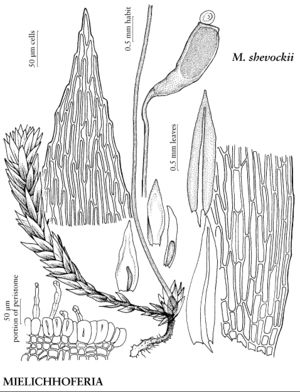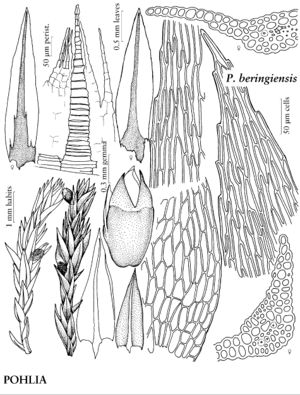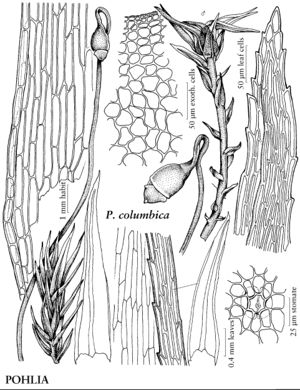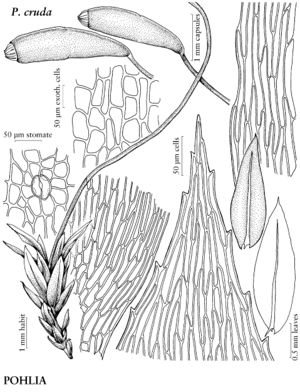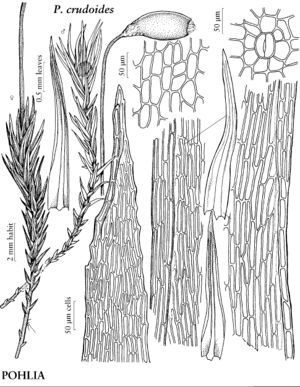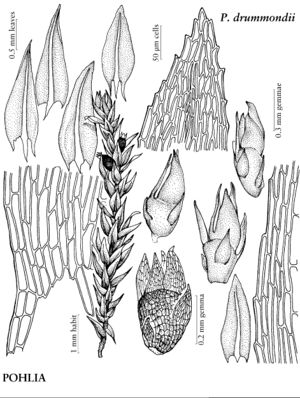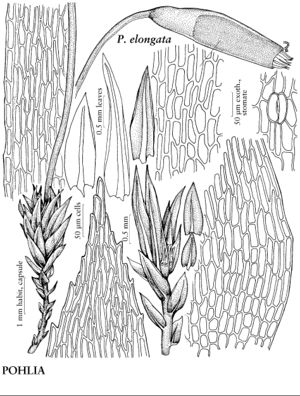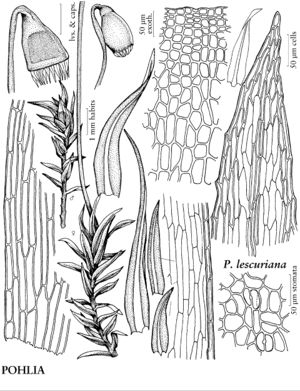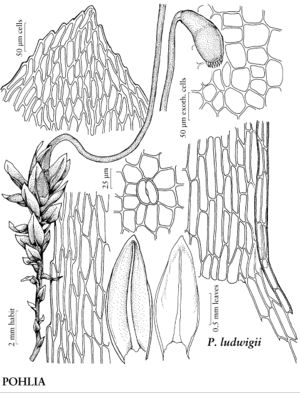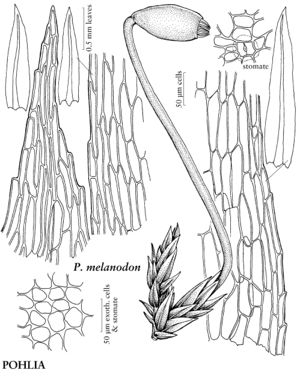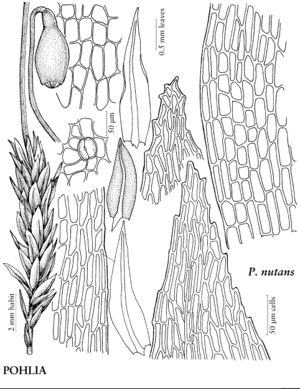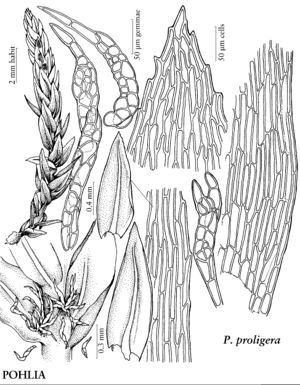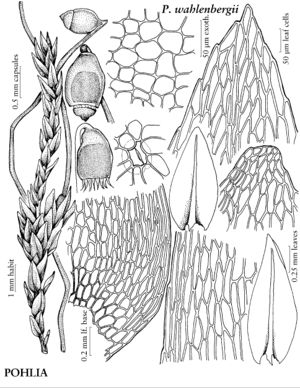Plants very small to large, as scattered individuals or colonies, green, reddish, whitish, or golden, often glossy when dry, acrocarpous. Stems short to long, sometimes complanate-foliate, unbranched or irregularly 2- to occasionally multifid when sterile; rhizoids few-to-many, pigmented, smooth to papillose, often bearing multicellular tubers. Leaves imbricate to slightly twisted when dry, erect to erect-spreading when moist, narrowly lanceolate, ovatelanceolate, or elliptic; base decurrent or not; margins plane or revolute, finely serrate to serrulate near apex, rarely entire; apex bluntly acute, acute, or short-acuminate; costa ending well before apex, subpercurrent, percurrent, or rarely short-excurrent, stereid band 1, well developed or occasionally reduced, guide cells usually present; proximal laminal cells usually rectangular, walls thin; distal medial cells elongate-hexagonal, rhombic, linear-rhomboidal, or sometimes narrowly vermicular, walls thin to thick; marginal cells undifferentiated to weakly but distinctly differentiated from medial cells [differentiated as distinct border, rarely red]. Specialized asexual reproduction absent or by spheric to ovoid rhizoidal tubers or axillary filiform to bulbiform gemmae. Sexual condition dioicous, paroicous, autoicous, or rarely synoicous or polyoicous; perigonia and perichaetia terminal or lateral; perigonia budlike, leaves broadly ovate, concave, base often brown to reddish, apex acute to long-acuminate, acumen erect to widespreading; perichaetial leaves same size as or smaller than vegetative leaves, sometimes strongly differentiated, lanceolate to linear-lanceolate, costa weaker. Seta 1 (–5), elongate. Capsule erect, inclined to 180°, or pendulous, long-exserted, narrowly cylindric to broadly pyriform or urceolate, neck well differentiated, sometimes 1+ times urn length; exothecial cells near mouth quadrate or short-rectangular, often reddish, in 1–3+ rows, walls thick, medial cells longer, short to long-rectangular, rarely isodiametric, walls straight or sinuate, sometimes collenchymatous; stomata many in neck, superficial to immersed; annulus revoluble or absent; operculum convex, short to long-conic, sometimes short-rostrate; peristome diplolepidous-alternate, rarely reduced or absent, 4: 2:4–6 (–8); exostome white, pale-yellow to brown, or rarely red, teeth triangular to lanceolate, rarely reduced or absent, trabeculate or not, pitted or rarely papillose proximally, coarsely or rarely finely papillose distally; endostome hyaline to yellow, basal membrane low to high, sometimes scarcely exceeding capsule rim, segments narrow to wide, strongly to weakly or scarcely keeled, rarely absent or reduced to rudimentary membrane, broadly to narrowly perforate or less commonly not, cilia absent or 1–3, as long as segments or shorter, nodulose or not. Calyptra fugacious, cucullate, smooth. Spores smooth to papillose, pale-yellow, tan, or nearly hyaline, rarely darker.
Distribution
Nearly worldwide, mostly Northern Hemisphere
Discussion
Genera 4, species ca. 150 (3 genera, 36 species in the flora).
Mielichhoferiaceae includes species traditionally classified in Bryaceae but phylogenetically closer to Mniaceae. Mielichhoferiaceae also includes Pseudopohlia R. S. Williams of Mexico. The leaves are narrowly to broadly lanceolate (sometimes elliptic or, in tropical species of Epipterygium, obovate to spatulate), with elongate distal laminal cells. The leaf margins are generally serrate to serrulate; laminal cells along the margins are weakly or undifferentiated in Mielichhoferia and Pohlia, moderately differentiated in Epipterygium tozeri. The peristome is fundamentally diplolepidous and double with well-developed exostome and endostome, but is variously reduced in many species. The stems in this family often bear subfloral innovations below the gametangia.
Among species of Epipterygium, the North American E. tozeri is most similar to species of Pohlia, especially those of the Mniobryum group (the latter sometimes treated as a subgenus of Pohlia or as a separate genus).
The three genera of Mielichhoferiaceae in the flora area were almost universally classified in Bryaceae until C. J. Cox and T. A. J. Hedderson (2003) published a phylogenetic study showing that these genera are more closely related to Mniaceae than to Bryaceae. This conclusion has been repeatedly corroborated by additional data from all three genomic compartments: nuclear, chloroplast, and mitochondrial. Phylogenetic resolution of precise relationships among genera in Mielichhoferiaceae and Mniaceae in the strict sense has been more recalcitrant (Cox, pers. comm.).
Selected References
None.
Lower Taxa
Illustrations
Key
| 1 | Peristome appearing single; endostome basal membranes rudimentary; perichaetia on short lateral branches. | Mielichhoferia |
| 1 | Peristome clearly double; endostome basal membranes low to high; perichaetia terminal, sometimes appearing lateral because of subfloral innovations | > 2 |
| 2 | Stems not complanate-foliate; dorsal and lateral leaves not differentiated; marginal cells undifferentiated or slightly narrower than medial cells; leaves narrowly lanceolate to ovate-lanceolate. | Pohlia |
| 2 | Stems slightly complanate-foliate; dorsal leaves in 1-3 rows, smaller than lateral leaves; marginal cells weakly but distinctly differentiated from medial cells; leaves ovate- lanceolate to elliptic. | Epipterygium |
"narrow" is not a number.

